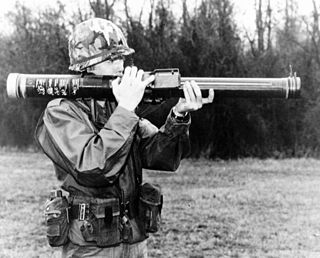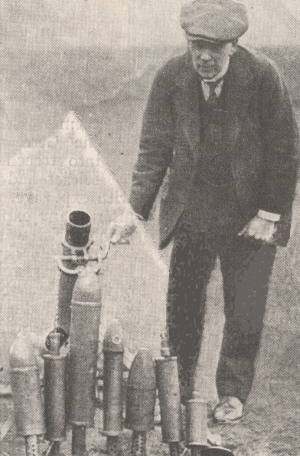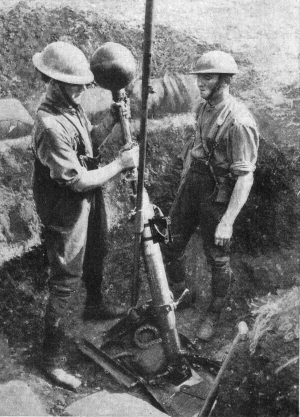
Des Moines County is located in the U.S. state of Iowa. As of the 2020 census, the population was 38,910. The county seat and largest city is Burlington. It is one of Iowa's two original counties along with Dubuque County; both were organized by the Michigan Territorial legislature in 1834. Des Moines County is part of the Burlington, IA–IL Micropolitan Statistical Area.

High-explosive anti-tank (HEAT) is the effect of a shaped charge explosive that uses the Munroe effect to penetrate heavy armor. The warhead functions by having an explosive charge collapse a metal liner inside the warhead into a high-velocity shaped charge jet; this is capable of penetrating armor steel to a depth of seven or more times the diameter of the charge. The shaped charge jet armor penetration effect is purely kinetic in nature; the round has no explosive or incendiary effect on the armor.

Anti-tank warfare originated during World War I from the desire to develop technology and tactics to destroy tanks. After the Allies deployed the first tanks in 1916, the German Empire introduced the first anti-tank weapons. The first developed anti-tank weapon was a scaled-up bolt-action rifle, the Mauser 1918 T-Gewehr, that fired a 13.2 mm cartridge with a solid bullet that could penetrate the thin armor used by tanks at that time and destroy the engine or ricochet inside, killing occupants. Because tanks represent an enemy's strong force projection on land, military strategists have incorporated anti-tank warfare into the doctrine of nearly every combat service since. The most predominant anti-tank weapons at the start of World War II in 1939 included the tank-mounted gun, anti-tank guns and anti-tank grenades used by the infantry, and ground-attack aircraft.

A grenade launcher is a weapon that fires a specially designed, large-caliber projectile, often with an explosive, smoke, or gas warhead. Today, the term generally refers to a class of dedicated firearms firing unitary grenade cartridges. The most common type are man-portable, shoulder-fired weapons issued to individuals, although larger crew-served launchers are issued at higher levels of organization by military forces.

The FGM-148 Javelin, or Advanced Anti-Tank Weapon System-Medium (AAWS-M), is an American-made man-portable anti-tank system in service since 1996 and continuously upgraded. It replaced the M47 Dragon anti-tank missile in US service. Its fire-and-forget design features automatic infrared guidance, allowing the user to seek cover immediately after launch, in contrast to wire-guided systems like the system used by the Dragon, which require a user to guide the weapon throughout the engagement. The Javelin's high-explosive anti-tank (HEAT) warhead can defeat modern tanks by top-down attack, hitting them from above, where their armor is thinnest, and is useful against fortifications in a direct attack flight. The Javelin uses a tandem charge warhead to circumvent an enemy tank's explosive reactive armor (ERA), which would normally render HEAT warheads ineffective.

The Avenger Air Defense System, designated AN/TWQ-1 under the Joint Electronics Type Designation System, is an American self-propelled surface-to-air missile system which provides mobile, short-range air defense protection for ground units against cruise missiles, unmanned aerial vehicles, low-flying fixed-wing aircraft, and helicopters.

In ballistics, the elevation is the angle between the horizontal plane and the axial direction of the barrel of a gun, mortar or heavy artillery. Originally, elevation was a linear measure of how high the gunners had to physically lift the muzzle of a gun up from the gun carriage to compensate for projectile drop and hit targets at a certain distance.

A dual-purpose improved conventional munition (DPICM) is an artillery or surface-to-surface missile warhead designed to burst into submunitions at an optimum altitude and distance from the desired target for dense area coverage. The submunitions use both shaped charges for the anti-armor role, and fragmentation for the antipersonnel role, hence the nomenclature "dual-purpose". Some submunitions may be designed for delayed reaction or mobility denial (mines). The air-to-surface variety of this kind of munition is better known as a cluster bomb. They are banned by more than 100 countries under the Convention on Cluster Munitions.

The Soltam K6 is a 120 mm mortar that was developed by Soltam Systems of Israel. It is the long-range version of the Soltam K5 and has replaced older systems, such as the 107-millimetre (4.2 in) M30, in several armies, including the United States Army. It is much lighter than the M30, has a greater range, and can sustain a rate of fire of four rounds per minute, while the M30 could sustain only three.
Nammo, short for Nordic Ammunition Company, is a Norwegian-Finnish aerospace and defence group specialized in production of ammunition, rocket engines and space applications. The company has subsidiaries in Finland, Germany, Norway, Sweden, Switzerland, Spain, the United Kingdom, the Republic of Ireland, and the United States. The company ownership is evenly split between the Norwegian government and the Finnish defence company Patria. The company has its headquarters in Raufoss, Norway.

The Stokes mortar was a British trench mortar designed by Sir Wilfred Stokes KBE that was issued to the British and U.S. armies, as well as the Portuguese Expeditionary Corps, during the latter half of the First World War. The 3-inch trench mortar is a smooth-bore, muzzle-loading weapon for high angles of fire. Although it is called a 3-inch mortar, its bore is actually 3.2 inches or 81 mm.

The 2 inch medium trench mortar, also known as the 2-inch howitzer, and nicknamed the "toffee apple" or "plum pudding" mortar, was a British smooth bore muzzle loading (SBML) medium trench mortar in use in World War I from mid-1915 to mid-1917. The designation "2-inch" refers to the mortar barrel, into which only the 22 in (560 mm) bomb shaft but not the bomb itself was inserted; the spherical bomb itself was actually 9 in (230 mm) in diameter and weighed 42 lb (19 kg), hence this weapon is more comparable to a standard mortar of approximately 5–6 in (130–150 mm) bore.

Ammunition, also known as ammo, is the material fired, scattered, dropped, or detonated from any weapon or weapon system. The term Ammunition includes both expendable weapons, and the component parts of other weapons that create the effect on a target.
Milan Army Ammunition Plant (MLAAP) was an ammunition plant of the United States Army Joint Munitions Command near Milan, Tennessee and about 23 miles (37 km) north of Jackson, Tennessee.

The Scranton Army Ammunition Plant (SCAAP) is a United States Army Joint Munitions Command (JMC) facility that manufactures large-caliber metal projectiles and mortar projectiles for the Department of Defense.
Crane Army Ammunition Activity (CAAA) in Crane, Indiana produces and provides conventional munitions requirements in support of United States Army and Joint Force readiness. It is one of 17 installations of the Joint Munitions Command and one of 23 organic industrial bases under the U.S. Army Materiel Command, which include arsenals, depots, activities and ammunition plants. Established in October 1977, it is located on Naval Support Activity Crane.

A mine shell or high-explosive, high-capacity (HEHC) in British military nomenclature, is a military explosive shell type characterized by thin shell walls and a correspondingly high quantity of explosives, much higher than the traditional high-explosive shell type per caliber, meaning that mine shells trade fragmentation effect for a higher pressure wave effect when comparing to traditional high-explosive shells.
The 120 mm M984 extended-range DPICM mortar round was developed by the US Army Ordnance. It is a 120mm caliber mortar cluster munition that can carry a variety of payloads including either 54 M80 dual-purpose submunitions or six mines. It can be optionally used with a range extending rocket in a tractor configuration which increases its range from 7.2 to around 12 kilometers.

Mahindra Armored Light Specialist Vehicle is a light-weight four-wheel drive air transportable tactical armoured specialist vehicle designed by Mahindra & Mahindra for the Indian Army and the Indian Special Forces. It's a modular type vehicle built to be maintenance friendly, and can be upgraded and configured for wide range of roles.

Munitions India Limited (MIL) is an Indian state-owned defence company, headquartered in Pune, India, established in 2021 as part of the restructuring and corporatisation of the Ordnance Factory Board into seven different Public Sector Undertakings. Munitions India primarily manufactures ammunition, explosives, rockets and bombs for the use of the Indian Armed Forces, foreign militaries and domestic civilian use.















